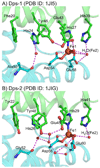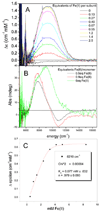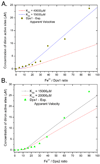CD and MCD spectroscopic studies of the two Dps miniferritin proteins from Bacillus anthracis: role of O2 and H2O2 substrates in reactivity of the diiron catalytic centers
- PMID: 21028901
- PMCID: PMC3075618
- DOI: 10.1021/bi101346c
CD and MCD spectroscopic studies of the two Dps miniferritin proteins from Bacillus anthracis: role of O2 and H2O2 substrates in reactivity of the diiron catalytic centers
Abstract
DNA protection during starvation (Dps) proteins are miniferritins found in bacteria and archaea that provide protection from uncontrolled Fe(II)/O radical chemistry; thus the catalytic sites are targets for antibiotics against pathogens, such as anthrax. Ferritin protein cages synthesize ferric oxymineral from Fe(II) and O(2)/H(2)O(2), which accumulates in the large central cavity; for Dps, H(2)O(2) is the more common Fe(II) oxidant contrasting with eukaryotic maxiferritins that often prefer dioxygen. To better understand the differences in the catalytic sites of maxi- versus miniferritins, we used a combination of NIR circular dichroism (CD), magnetic circular dichroism (MCD), and variable-temperature, variable-field MCD (VTVH MCD) to study Fe(II) binding to the catalytic sites of the two Bacillus anthracis miniferritins: one in which two Fe(II) react with O(2) exclusively (Dps1) and a second in which both O(2) or H(2)O(2) can react with two Fe(II) (Dps2). Both result in the formation of iron oxybiomineral. The data show a single 5- or 6-coordinate Fe(II) in the absence of oxidant; Fe(II) binding to Dps2 is 30× more stable than Dps1; and the lower limit of K(D) for binding a second Fe(II), in the absence of oxidant, is 2-3 orders of magnitude weaker than for the binding of the single Fe(II). The data fit an equilibrium model where binding of oxidant facilitates formation of the catalytic site, in sharp contrast to eukaryotic M-ferritins where the binuclear Fe(II) centers are preformed before binding of O(2). The two different binding sequences illustrate the mechanistic range possible for catalytic sites of the family of ferritins.
Figures








Similar articles
-
Paired Bacillus anthracis Dps (mini-ferritin) have different reactivities with peroxide.J Biol Chem. 2006 Sep 22;281(38):27827-35. doi: 10.1074/jbc.M601398200. Epub 2006 Jul 21. J Biol Chem. 2006. PMID: 16861227
-
CD/MCD/VTVH-MCD Studies of Escherichia coli Bacterioferritin Support a Binuclear Iron Cofactor Site.Biochemistry. 2015 Dec 1;54(47):7010-8. doi: 10.1021/acs.biochem.5b01033. Epub 2015 Nov 18. Biochemistry. 2015. PMID: 26551523
-
Spectroscopic definition of the ferroxidase site in M ferritin: comparison of binuclear substrate vs cofactor active sites.J Am Chem Soc. 2008 Jul 23;130(29):9441-50. doi: 10.1021/ja801251q. Epub 2008 Jun 25. J Am Chem Soc. 2008. PMID: 18576633 Free PMC article.
-
The iron redox and hydrolysis chemistry of the ferritins.Biochim Biophys Acta. 2010 Aug;1800(8):719-31. doi: 10.1016/j.bbagen.2010.03.021. Epub 2010 Apr 9. Biochim Biophys Acta. 2010. PMID: 20382203 Review.
-
Ferritin: the protein nanocage and iron biomineral in health and in disease.Inorg Chem. 2013 Nov 4;52(21):12223-33. doi: 10.1021/ic400484n. Epub 2013 Oct 8. Inorg Chem. 2013. PMID: 24102308 Free PMC article. Review.
Cited by
-
An Overview of Dps: Dual Acting Nanovehicles in Prokaryotes with DNA Binding and Ferroxidation Properties.Subcell Biochem. 2021;96:177-216. doi: 10.1007/978-3-030-58971-4_3. Subcell Biochem. 2021. PMID: 33252729 Review.
-
Ferritin protein nanocages use ion channels, catalytic sites, and nucleation channels to manage iron/oxygen chemistry.Curr Opin Chem Biol. 2011 Apr;15(2):304-11. doi: 10.1016/j.cbpa.2011.01.004. Epub 2011 Feb 4. Curr Opin Chem Biol. 2011. PMID: 21296609 Free PMC article. Review.
-
Dps Functions as a Key Player in Bacterial Iron Homeostasis.ACS Omega. 2023 Sep 11;8(38):34299-34309. doi: 10.1021/acsomega.3c03277. eCollection 2023 Sep 26. ACS Omega. 2023. PMID: 37779979 Free PMC article. Review.
-
Structure/function correlations over binuclear non-heme iron active sites.J Biol Inorg Chem. 2016 Sep;21(5-6):575-88. doi: 10.1007/s00775-016-1372-9. Epub 2016 Jul 1. J Biol Inorg Chem. 2016. PMID: 27369780 Free PMC article. Review.
-
Ferritins for Chemistry and for Life.Coord Chem Rev. 2013 Jan 15;257(2):579-586. doi: 10.1016/j.ccr.2012.05.013. Epub 2012 May 18. Coord Chem Rev. 2013. PMID: 23470857 Free PMC article.
References
-
- Lewin AC, Moore GR, Le Brun NE. Formation of protein-coated iron minerals. Dalton Trans. 2005;21:3597–3610. - PubMed
-
- Su M, Cavallo S, Stefanini S, Chiancone E, Chasteen ND. The So-Called Listeria innocua Ferritin Is a Dps Protein. Iron Incorporation, Detoxification, and DNA Protection Properties. Biochemistry. 2005;44:5572–5578. - PubMed
-
- Liu X, Kim K, Leighton T, Theil EC. Paired Bacillus anthracis Dps (mini-ferritin) have different reactivities with peroxide. J. Biol. Chem. 2006;281:27827–27835. - PubMed
-
- Chiancone E, Ceci P. The multifaceted capacity of Dps proteins to combat bacterial stress conditions: Detoxification of iron and hydrogen peroxide and DNA binding. Biochimica et biophysica acta. 2010;1800:798–805. - PubMed
Publication types
MeSH terms
Substances
Grants and funding
LinkOut - more resources
Full Text Sources
Miscellaneous

